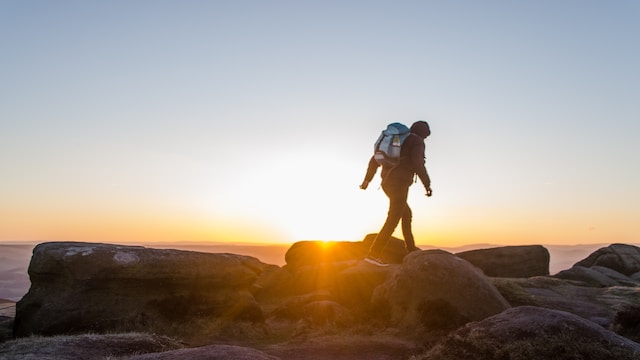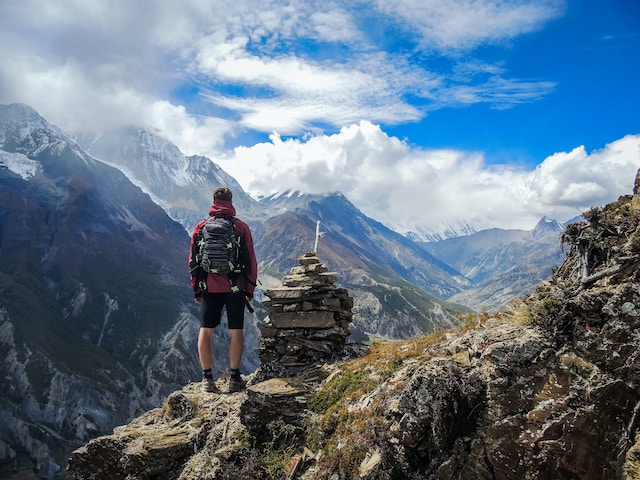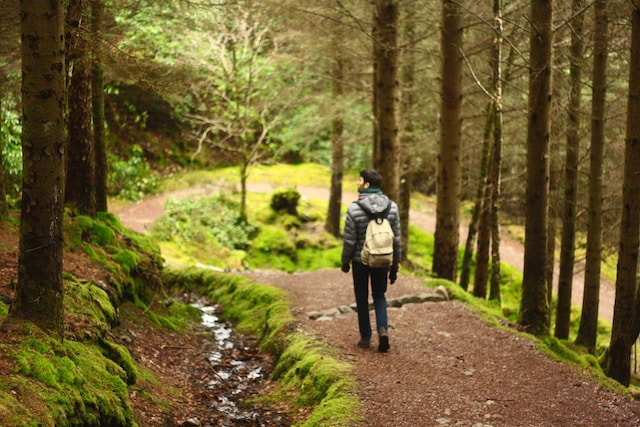Hiking and trekking are two different outdoor activities that offer unique experiences to enthusiasts. Hiking is usually shorter, less intense and takes place on well-marked trails while trekking requires more preparation with a longer duration over rugged terrains. Both activities have numerous benefits including physical fitness, stress relief and connection with nature. However, it’s important to note that there are also dangers associated with hiking and trekking such as injuries or getting lost.
What is hiking?
(Photo by Usman Omar on Unsplash )

Hiking is the activity of walking on trails or paths in natural environments, usually with the intention of enjoying nature and getting some exercise. It’s a great way to unwind, escape from daily life, and explore new landscapes. Hikes can range from short walks in local parks to multi-day treks through remote wilderness areas.
Hiking can be done anywhere there are trails or paths available – from mountains and hills to forests and deserts. The terrain can vary greatly depending on where you’re hiking, but it often involves uneven ground, rocks, roots, streams, and steep inclines.
One of the best parts about hiking is that it doesn’t require any special equipment beyond comfortable shoes and clothing appropriate for the weather conditions. However, if you plan on going on longer hikes or more challenging routes then investing in good quality gear such as backpacks with hydration systems or trekking poles may become necessary.
Hiking is an excellent way to connect with nature while also improving your physical health. Whether you’re seeking a leisurely stroll or a challenging adventure through rugged terrain – there’s something for everyone who enjoys spending time outdoors!
What is trekking?
(Photo by Simon English on Unsplash )

Trekking is often confused with hiking due to their similarities, but they are distinct activities. Trekking involves traveling through a remote area for multiple days while carrying all of one’s necessary supplies and equipment. It usually takes place in mountainous or wilderness areas and can involve significant altitude changes.
Trekking requires more physical fitness than hiking as it often involves longer distances, steeper inclines, and uneven terrain. Additionally, trekkers must be self-sufficient as there are no amenities available in the wilderness.
Treks may last anywhere from several days to several weeks or even months depending on the route chosen. Trekkers typically camp at night in tents or lodges along the way.
Some popular trekking destinations include the Himalayas, Patagonia, and Everest Base Camp in Nepal. Trekking allows individuals to experience nature up close while also challenging themselves both physically and mentally.
Trekking offers an unforgettable adventure for those who have a passion for exploring new horizons and pushing their limits beyond what they thought was possible.
Hiking Vs. Trekking – Key differences
Hiking and trekking are two outdoor activities that involve walking or hiking on a trail, but there are some key differences between the two. The main difference lies in the duration, difficulty level, and terrain type of each activity.
Hiking is usually a day trip where people walk on trails for a few hours to up to 1 day. It can be done with minimal equipment like comfortable shoes, water bottle and sun protection gear. On the other hand, trekking involves multi-day trips that require more preparation and planning. Trekking requires specialized equipment such as tents, sleeping bags, cooking utensils etc.
Another significant difference is in terms of difficulty level. Hiking trails are generally well-maintained paths with less elevation gain while trekking involves difficult terrain types like mountains or wilderness areas which can be challenging even for experienced hikers.
Finally on cost – hiking is typically cheaper because it doesn’t require specific gear or an extended time period while treks often involve additional costs like guide fees as well as renting/buying special equipment.
Why people enjoy hiking and trekking
Hiking and trekking are two activities that attract people from all walks of life. One of the main reasons why people enjoy hiking and trekking is the opportunity to connect with nature. It allows individuals to explore new environments, see wildlife up close, and experience breathtaking views that can only be seen on foot.
Another reason why people love these outdoor activities is for the physical challenge they provide. Hiking and trekking require endurance, strength, and mental toughness. The feeling of accomplishment after completing a difficult trail or reaching a summit cannot be matched.
For some individuals, hiking and trekking serve as an escape from their busy lives filled with technology and screens. Being disconnected from social media and email allows them to clear their minds, reduce stress levels, and focus solely on the present moment.
Furthermore, hiking and trekking offer an opportunity to spend quality time with loved ones or meet like-minded individuals who share similar interests in exploring nature.
It’s not just one factor that draws people towards hiking nor is there one answer as to why they enjoy it so much; rather it’s a combination of factors including adventure seeking spirits who are constantly looking for new ways to challenge themselves both physically & mentally while experiencing something unique every step of the way!
What is backpacking?
Backpacking refers to a form of travel where an individual carries all necessary equipment and supplies in a backpack while hiking or trekking. It typically involves exploring remote areas for extended periods, with the primary goal being self-sufficiency.
When backpacking, you carry everything you need on your back, including food, shelter, clothing and other essential items. This means that careful planning is crucial to ensure that you have everything required for the trip without overloading yourself.
Backpacking provides the freedom to explore nature at your own pace and on your own terms. It allows travelers to immerse themselves in different cultures while enjoying outdoor activities such as hiking, camping and rock climbing.
To embark on a backpacking adventure, it’s important to have proper gear such as sturdy footwear, a high-quality backpack designed specifically for long hikes carrying heavy loads, sleeping bag and pad among others.
If you enjoy spending time outdoors surrounded by breathtaking scenery and crave adventure off the beaten path then perhaps backpacking is just what you need!
Equipment needed for hiking and trekking
When it comes to hiking and trekking, having the right equipment is crucial for a safe and enjoyable experience. Here are some essential items you’ll need:
Footwear: A sturdy pair of hiking boots or shoes with good ankle support is a must-have.
Clothing: Dress in layers so that you can adjust your temperature as needed. Choose moisture-wicking fabrics that will keep you dry and comfortable.
Backpack: You’ll want a backpack big enough to carry all of your essentials, but not so big that it becomes cumbersome.
Navigation tools: Bring a map, compass, or GPS device to help guide you on your journey.
Food and water: Pack plenty of snacks and water to keep yourself fueled throughout the day. Consider bringing a water filter if you’ll be hiking in areas where clean drinking water may not be available.
Emergency kit: Always be prepared for emergencies by packing items such as a first-aid kit, whistle, flashlight, and extra batteries.
Types of trekking
One type of trekking is through mountainous regions that involve high altitude expeditions requiring specialized equipment such as crampons, ice axes and ropes. This type of trek is not for the faint-hearted and requires adequate training before attempting.
Another type is jungle trekking where trekkers explore dense forests with lush vegetation while encountering exotic wildlife along the way. Jungle treks are usually shorter in duration than mountainous ones but still provide an adrenaline-filled adventure.
Cultural treks are another form of trekking that allows hikers to engage in local customs and interact with indigenous communities while exploring scenic landscapes. These cultural experiences are ideal for travelers who seek authentic encounters with locals.
There’s desert trekking which allows you to walk across vast sand dunes typically found in arid regions like Africa or the Middle East. Desert hikes present unique challenges due to extreme temperatures; however they’re rewarding given their breathtaking views at dawn or dusk.
Whichever style one chooses for their next adventure – be it hiking or trekking – all offer endless opportunities for self-discovery whilst experiencing nature’s beauty!
Benefits of hiking and trekking
Hiking and trekking are not only great ways to explore the outdoors but also offer several health benefits. Regular hiking can improve cardiovascular health, muscular endurance, and overall fitness levels. Trekking on challenging terrains requires more effort and is a great way to build strength in your legs, core muscles, and upper body.
Being surrounded by nature during hikes or treks has a positive impact on mental wellbeing too. It reduces stress levels, anxiety symptoms and improves mood. Taking time out of our busy schedules for these activities helps us unplug from technology-induced distractions to enjoy simple pleasures like fresh air that calms the mind.
Hiking and trekking are often social activities where you bond with fellow hikers or trekkers while experiencing different cultures in exotic locations around the world. The shared experience of accomplishing long-distance goals creates lasting memories as well as building strong bonds between participants.
Another significant benefit of hiking or trekking is the opportunity it gives us to disconnect from urban life for a while. This break allows us to appreciate how we live our daily lives better; it opens up new perspectives that may enlighten us about making changes necessary for personal growth.
Regular hiking or trekking comes with many physical, emotional and psychological benefits that make them worthwhile activities to engage in regularly if you have access to suitable trails near you!
Dangers of hiking and trekking
While hiking and trekking can be exciting and enjoyable experiences, they come with certain risks that need to be taken seriously. One of the most common dangers when hiking or trekking is getting lost or losing your way on unfamiliar terrain. This can happen if you don’t properly plan your route or if you venture off the trail.
Another danger to keep in mind is wildlife encounters. While rare, it’s important to know what animals are native to the area you’ll be hiking in and how to avoid confrontation with them. This includes carrying bear spray, being aware of cougar behavior, and knowing how to respond if a venomous snake crosses your path.
Weather conditions can also pose a threat while out on a hike or trek. It’s crucial to check weather forecasts beforehand and pack appropriate clothing for any potential changes in temperature or precipitation.
Injuries such as sprains, strains, blisters, cuts or broken bones may occur while walking on difficult terrains like rocky surfaces or steep slopes without proper footwear.
By being prepared for these dangers before hitting the trails through careful planning , having an emergency kit ready at all times along with taking necessary precautions people will have much safer outdoor adventures!
Featured Image By – tamara garcevic on Unsplash








